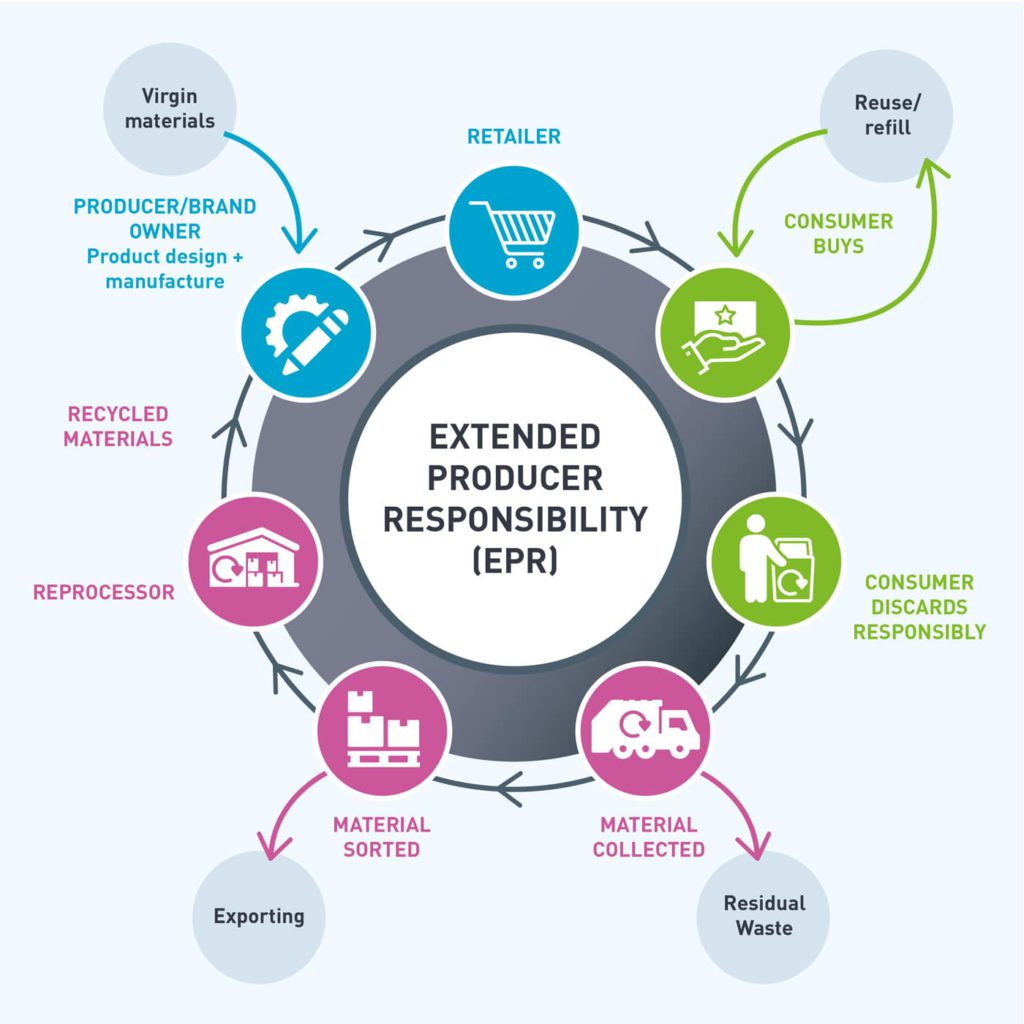2025 Sustainable Packaging Goals

A recent study by Google predicts that the next two decades could witness mismanagement of a whopping 7.7 gigatons of plastics based on the current global plastic production rates. To understand how astronomical this figure is, the weight of 7.7 gigatons of plastic waste would surpass the entire weight of all the humans on earth by sixteen times over.

Though this is an alarming direction to head into, businesses are positive about achieving their 2025 sustainable packaging goals. The New Plastics Global Economy Commitment has been unifying several companies towards achieving this sustainable goal and handling difficult challenges that might arise in the process.
AptarGroup manager for global sustainability, Taylor Price quotes “We’ve really seen 2025 become this big date in our industry. It’s the year to get a lot of things done.” AptarGroup is a major player in the product delivery and consumer packaging industry.
There is still a lot to do to reduce plastic waste and make way for a sustainable future which requires a fair bit of investment in recycling technology and infrastructure with an emphasis on reuse.
Here is a brief look at the key takeaways from Circularity 2021 about packaging goals:
Goals for Sustainable Packaging
1. Goals are needed to be implemented to action:
Executive director of the newly formed US Plastics Pact, Emily Tipaldo said that though the commitment and dedication have been at an all-time high regarding sustainable packaging, businesses will need to strategize and start working towards the goals that are in their control.
Director of Sustainable Packaging Coalition and GreenBlue director Nana Goodrich shared the same sentiment as Tipaldo. Goodrich noted that businesses that have started implementing sustainable plans have understood the start difference between achieving the actual goal in contrast to giving out statements. There are several metrics and measurements in play that companies have to address before they can start working on the goals.
“For us, the lifecycle assessment has been really helpful in understanding eco-design principles but also, what does that mean to our customers, our suppliers, when we’re making changes.”
2. New tools that can help implement these sustainable goals.
PlasticIQ is a free tool launched by the Recycling Partnership last month to help companies of all sizes to realise their sustainable goals, no matter where they are on their journey of fulfilment. The tool was created in collaboration with Walmart and SystemIQ, which helps companies to keep a track of their plastic footprint and minimise them through a systematic list of polarised actions.
Vice president of circular ventures at the Recycling Partnership, Sarah Dearman noted that the tool will help companies to visualise their plastic use and help them focus on reuse and recyclability. Dearman notes “As you choose the different options within the tool…you can visually see what the impact is going to be on your plastic footprint as you move into the future, and that helps you develop your strategy.”
Companies can also refer to other resources like the Ellen MacArthur Foundation’s Report and its 2020 Report Card to learn more about the commitments and the progress of their peers in achieving sustainability.
3. Begin with a goal and seek guidance from experts:
Companies like Tetra Pak, Gillette, AptarGroup, Dr Pepper and the BlueTriton brands all offered valuable advice in achieving sustainability goals. These advices include:
Have a roadmap to follow
Having a roadmap gives companies a clear objective that they need to achieve in the future. Vice president and chief sustainability officer of BlueTriton Brands, David Tulaukas said that “It’s helpful to start with what’s your vision of the future, where do you want to be as a company in 2030, 2040… and then work backwards based on what are the issues and opportunities important to you,”
Charlie Schwarze, director of sustainable packaging of Keurig Dr Pepper said that the company has been actively looking at their portfolio and sough for the possibilities of sustainable solutions which has helped the organisation to come up with an effective roadmap before they announce their goals.
Be Data-Driven
Understanding and analysing the data has helped companies to come up with eco-friendly design principles. Price of AptarGroup said that “For us, the lifecycle assessment has been really helpful in understanding eco-design principles but also, what does that mean to our customers, our suppliers when we’re making changes. Having that deep understanding and the data to back that up has been really important.”
Surveying the customer preferences to understand the sustainable packaging needs has helped the organisations like Gillette to get internal buy-in to set the goals for the organisation as noted by the R&D technical director for sustainable packaging at Gillette, Jeff Grene.
Do not try more than you can handle
Organisations must have realistic expectations and be able to set logical goals that can be achieved. Failing to set such goals will lead to frustration notes Tetra Pak sustainability transformation manager for the Americas, Luana Pinheiro.
A good idea is to break the goals into smaller achievable tasks that can be assigned to different teams to make the operations smoother allowing organisations to reach their sustainability goals more easily.
Keurig Dr Pepper director of sustainable packaging, Charlie Schwarze said that “Whether it’s a brand that’s working toward a target or a format type that we’re working to replace or redesign, it helps to break that into a specific task for an assignable person.”
Seek help from external experts
External organisations can help companies achieve their goals more easily by driving meaningful changes. Pinheiro from Tetra Pak notes that organisations like the Science-Based Targets initiative can help companies to stay on track and help them commit to the set goals.
4. Collaboration is key:
Organisations cannot achieve their sustainability goals individually and there is a major need for collaboration. Schwarze notes that 2025 is just around the corner and organisations need to work together if they are looking to achieve their goals. He notes that keeping teams on track is the most crucial thing to look for and external partnerships can be quite helpful for efficient collaboration. Organisations like Polypropylene Recycling Coalition have been actively working to help companies address any challenges like flexible packaging etc.
The AptarGroup has joined the Ellen MacArthur Foundation and is working actively to bring forth better sustainable packaging recyclability and innovation to help brands across the world to reach their sustainability goals. It is something AptarGroup would not have been able to achieve without external help.
“Whether it’s a brand that’s working toward a target or a format type that we’re working to replace or redesign, [it helps] to break that into a specific task for an assignable person.”
Pinheiro and Tulauskas also noted the importance of collaborating with peers and said that companies have partnered up to lead to a sustainable future. Companies like Tetra Pak has already founded the Carton Council decades ago that has helped in the recycling of sustainable packaging cartons. Pinheiro cites that they have witnessed great results.
5. Policymakers need to understand the momentum of the EPR
100 businesses in the packaging industry joined with 50 other organizations to issue a statement calling for the EPR or Extended Producer Responsibility in mid-June. This meant that companies would need to bear the responsibility of the sustainable packaging that they send to the market and pay for the collection, sorting, and recycling of these sustainable packaging materials.
Since the beginning of 2021, the EPR has gained a lot of support and policymakers should take note of the growing momentum.
Ellen MacArthur Foundation leads for new plastics economy, Sander Defruyt said that without acting on the momentum, the recycling rates will never reach a meaningful scale.
Tulauskas noted that the EPR has gained massive traction in the US and also some organizations are agnostic towards the policy. Such modern policies must be implemented to ensure that the recycling rates improve.
6. Increase reuse
The three breakout sessions of the Circularity 2021 featured little talk about reuse and Defruyt notes that without focusing on reuse, there will be a huge gap in the circular economy of plastics, and recycling alone won’t be able to solve the problem.
He notes that there is a need for organizations to step up their efforts to reuse plastics and move away from the throwaway model. Defruyt notes that there are small scale efforts seen with organizations which are still not enough to make a difference,
7. Investing in infrastructure
Recent studies by Google indicate that there are six polymers that are in high demand across the major three regions of the globe that make up for 86 percent of the entire global demand.
The study noted that there is a need to invest in infrastructure for recycling five to six times within 2040 if organizations need to stay on track with their sustainability goals and also increase their chemical recycling facilities by 100 percent. This put a hefty price tag on the investment which is calculated to be around $500 billion globally.
Werner said that “We need to have a global conversation about how to unlock the capital required to invest in these strategic interventions, we can’t produce a circular economy for plastics if we don’t have the infrastructure to process plastic feedstocks into recycled plastics.”
Learn how IIT Roorkee took a step towards sustainable paper packaging



